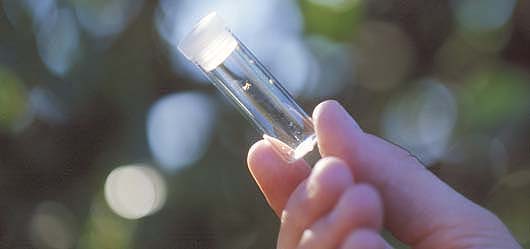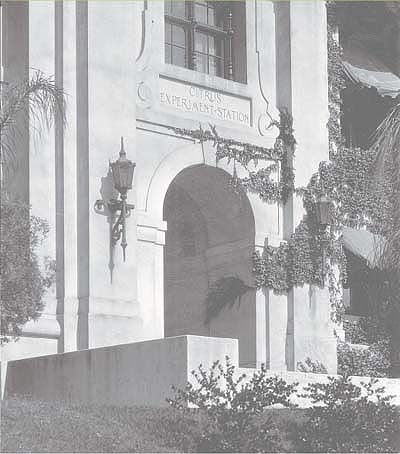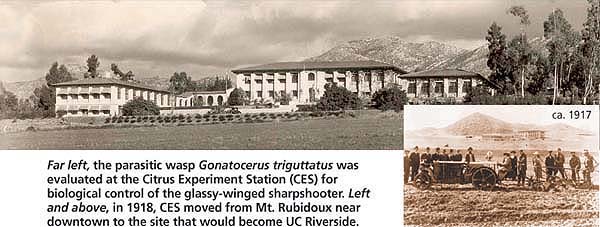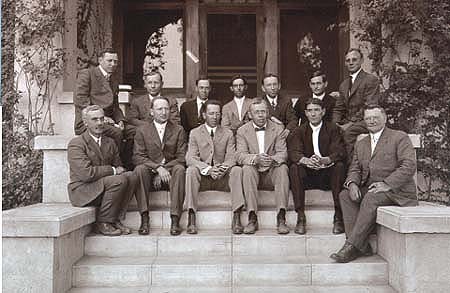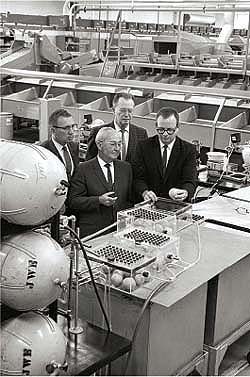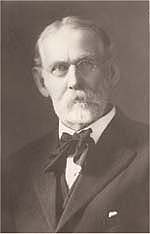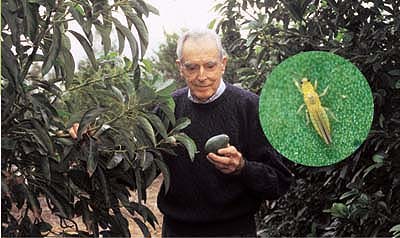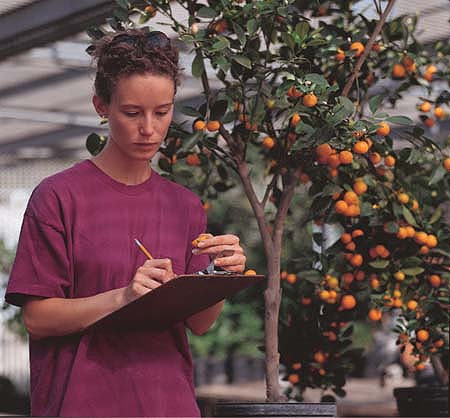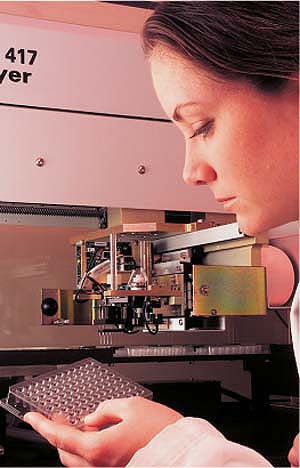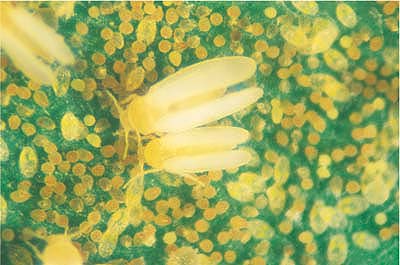All Issues
AES Centennial 100: UC Riverside marks a century of agricultural innovation — still thriving in an urban empire
Publication Information
California Agriculture 60(4):176-179.
Published October 01, 2006
PDF | Citation | Permissions
NALT Keywords
Full text
The parasitic wasp Gonatocerus triguttatus was evaluated at the Citrus Experiment Station (CES) for biological control of the glassy-winged sharpshooter.
Early in the 20th century, when the citrus belt cut a wide swath from Pasadena to Redlands, an outpost experiment station operated by UC helped to ensure, through science, the prosperity of what was even then a $20 million industry.
Today, sprawling suburban developments, gleaming midrise office towers and crowded shopping malls have replaced all but a few pockets of Southern California's citrus empire. Yet the citrus industry thrives in California, and the experimental outpost known as the Citrus Experiment Station (CES) in Riverside has grown and expanded its mission in support of the state's diverse, nearly $32 billion agricultural industry — still tops in the nation.
This year marks the centennial of UC Riverside's Citrus Research Center-Agricultural Experiment Station (CRC-AES). What began in 1906 with a staff of two at the base of Mt. Rubidoux near downtown Riverside is today a multifaceted enterprise involving 140 faculty and specialists in the experiment station and Cooperative Extension, and an annual budget of approximately $22 million. The CRC-AES now tackles a broad array of agricultural, urban and natural resource problems with fundamental and applied research in plant biology, pest and disease management, and the environment and natural resources. They are supported with advanced facilities, such as a state-of-the-art Insectary and Quarantine Facility and two campus-operated field stations totaling nearly 1,000 acres.
“This campus has a legacy of research in agriculture and natural resources that has strengthened one of this state's most important industries and helped it remain competitive, whether that meant surmounting new insect pests and plant diseases or developing new products for new markets,” says Steven R. Angle, dean of the UC Riverside College of Natural and Agriculture Sciences.
The centennial celebration commenced with a barbecue and open house in April, featuring tours of the on-campus field station and ceremonial plantings of the UC Riverside-developed mandarins ‘Gold Nugget’ and ‘Yosemite Gold’. It continues this October with groundbreaking of the $53.9 million Genomics Building on campus and, next February, a banquet and symposium that takes a prospective look at the next century of agricultural sustainability ( see box, page 179 ).
“The contributions of UC Riverside are woven throughout the citrus industry, not only in California, but nationally and internationally,” says Ted Batkin, president of the Citrus Research Board in California and chair of the National Citrus Research Council. “What is so impressive is the connection between the Agricultural Experiment Station and Cooperative Extension specialists. It is seamless in providing a continuum of basic discoveries through field application and it is what makes the Riverside campus particularly distinctive.”
Above, in 1918, CES moved from Mt. Rubidoux near downtown to the site that would become UC Riverside.
A “valentine” for Riverside
The official establishment of the Citrus Experiment Station is pegged to the date that the UC Board of Regents formally approved the leases for the Riverside property — Feb. 14, 1907 — though the station had begun operating some months prior. Opening of the station followed a vigorous lobbying effort by leaders of the Riverside Horticultural Club and Southern California Fruit Growers Exchange, a mission that landed Riverside the citrus station and Whittier a pathological laboratory.
When it came time to upgrade and expand the station, an intense political battle was waged between Riverside and the San Fernando Valley, a then-emerging citrus belt with powerful lobbying interests related to development and construction of the aqueduct from the Owens Valley to Los Angeles. Riverside viewed itself as the underdog, so there was wild elation in the streets when, on Dec. 22, 1914, the UC Regents voted to retain the station in Riverside.
In a day now famous in Riverside history, the steam whistle at the electric plant blew for 15 minutes and Mission Inn owner Frank Miller ordered the bells at the hotel be rung continuously. Riverside civic leader and citrus pioneer John Henry Reed called it “the most important day in the history of Riverside” in the Riverside Daily Press.
The expanded station moved in 1918 to the eastern edge of the city, on a site that would become UC Riverside in 1954, occupying a stately Spanish mission-style headquarters — a building now designated as a Riverside County historical landmark. (Today it houses UC Riverside's A. Gary Anderson Graduate School of Management.)
Groundbreaking research
Experiment station scientists conducted groundbreaking research that led to the delivery of new varieties of citrus and other commodities, innovative pest management techniques utilizing advances in biological control and integrated pest management (IPM), and new insights on California's natural resources that would inform both environmental quality and crop production.
Among early accomplishments was the control of the citrophilus mealybug by a natural enemy, one of the station's first ventures in biological control. In the 1940s, Herbert John Webber and Leon D. Batchelor — the station's first and second director, respectively — published The Citrus Industry, a comprehensive two-volume work compiling scientific knowledge about the distribution, botany, genetics and reproduction of citrus. Tristeza disease, which threatened to wipe out California's citrus industry starting in the 1930s, was solved after station scientists determined that the disease was caused by a virus; a new disease-resistant rootstock was developed by W.P. (Bill) Bitters, who also served as director of the Citrus Variety Collection for 35 years.
The late George Zentmyer was a world authority on Phytophtora cinnamomi, a fungus afflicting avocados and other tropical plants; inset, avocado thrips.
Shortly after its formation, the station expanded its mission to include work on many other subtropical crops. The Riverside station gained a strong reputation in the avocado industry, due in large part to the efforts of George Zentmyer — later elected to the prestigious National Academy of Sciences — who would be credited with saving the industry from avocado decline disease with his work on the soilborne fungus Phytophthora cinnamoni and his introduction of resistant rootstock.
The UC Riverside College of Natural and Agricultural Sciences developed the Core Instrumentation Facility to support research in genome biology.
Following World War II, and under the direction of Alfred M. Boyce, the Citrus Experiment Station enjoyed its greatest growth. When UC Riverside was designated a general campus in 1960, a College of Agriculture was established and new departments in agronomy, agricultural engineering and biostatistics were initiated to augment the station's existing departments.
Experiment station scientists investigated new pesticides and earned a reputation for pioneering studies on insect resistance to pesticides and the measurement of insecticide residues, methods that would become part of the federal evaluation for commercial pesticide approval. The Citrus Clonal Protection Program was founded, today serving as the only approved importation facility in the nation for citrus.
Also in the 1960s, the first International Citrus Symposium was held at UC Riverside — organized by the late Homer D. Chapman — drawing 800 delegates from more than 50 countries and leading to the formation of the International Society of Citriculture (ISC). ISC, still headquartered at UC Riverside, has convened congresses around the world ever since, with the next one scheduled for 2008 in China.
The second 50 years
When it entered its second half-century the experiment station carried out a diverse, broad-based research program, but citrus remained an important focus area and scientists retained the strong sense of service to the industry upon which the station was founded. Says plant physiologist Charlie Coggins, who arrived at the station in 1957, “Good, practical research was considered to be what we were all about, and strong fundamental research was expected as an underpinning to that applied research.” Coggins' work on growth regulators beginning in the 1960s dramatically extended California's navel orange growing season.
Research at the CRC-AES broadened again in the 1970s under W. Mack Dugger, incorporating such new scientific disciplines and techniques as molecular biology, IPM and genetics. Environmental protection and the challenges associated with agriculture in arid and semiarid regions became new focus areas. New crops were developed, including turfgrass varieties with tolerance to soil salinity and air pollution. The campus also became a leader in plant tissue culture.
At the three-quarter-century mark, the CRC-AES was led by deans Irwin Sherman, now professor emeritus of zoology, then Seymour D. Van Gundy, now professor emeritus of nematology. It was an era during which the still-new discipline of molecular biology was maturing, with IPM and biological control remaining robust areas of research. In one particularly dramatic case, the importation and establishment of a tiny stingless wasp brought the ash whitefly under control. This bothersome pest not only caused millions of dollars in damage to agriculture, but it also despoiled cars parked under landscape trees with sticky excrement. It was a case that brought Citrus Experiment Station research to bear on the urban community, bringing widespread media attention to the UC Riverside campus.
Left, Distinguished Professor Natasha Raikhel, director of the Center for Plant Cell Ciology, and students. Above, turfgrass research.
The last quarter-century has also seen the release of several patented new varieties of citrus, starting with the ‘Oroblanco’ grapefruit in 1981 and continuing with the recent release of the ‘Tango’ mandarin. Likewise, development of the GeneChip Citrus Genome Array will help scientists quickly examine genetic traits in citrus so they can develop new varieties and tackle disease and postharvest problems. Another breeding program at UC Riverside has yielded cowpea lines that are early-maturing and heat-tolerant, making them particularly well-suited to the drought conditions of West Africa, helping to reduce hunger and poverty there.
Current research initiatives
The College of Natural and Agricultural Sciences has since undertaken a major initiative in genome biology, begun under the leadership of former dean Michael T. Clegg and continuing today. UC Riverside's Institute for Genome Biology and Center for Plant Cell Biology, created to capitalize on the emerging genomics revolution and on expertise in the experiment station, is applying genomics to solve critical health and agriculture-related problems, such as malaria and abiotic stresses to plants. Associated with the institute is the Biotechnology Impacts Center, which serves as an “honest broker” to identify the relevant policy issues related to the potential risks of genomic modification, act as a clearinghouse for credible information and initiate research that addresses its potential benefits and consequences.
California's population growth, leading to environmental problems associated with the urban-wildland and urban-agriculture interfaces, has prompted a renewed focus on natural resource protection. UC Riverside's Center for Conservation Biology generates objective scientific data to inform the development of public policy and restoration plans to preserve endangered species. The experiment station is also expanding its capabilities in environmental and natural resource economics.
On the occasion of the centennial, the College of Natural and Agricultural Sciences — with guidance from the Chancellor's Agricultural Advisory Council and faculty — is undertaking a strategic planning process to chart its course for the next one. “We have served the agricultural industry well for 100 years,” says Executive Associate Dean Donald Cooksey. “Now we need to determine how best to face the next century. Are we well-positioned for the future?”
In the near term, that future is expected to include a continued emphasis on water science with pending formation of a Center for Water Quality Science and Policy to address problems that are projected to become even more acute as demand by urban and agricultural consumers increases. Pest management, especially as it relates to invasive species, is expected to remain among the priorities, as is natural resources, in part through the college's participation in the campuswide Environmental Research Institute.
There will be no shortage of challenges and opportunities for California's agricultural industry.
“As our population increases rapidly, we will lose more of our land and water resources for agriculture,” says Van Gundy, chair of the centennial celebration planning committee. “We are going to have to focus on more intensive agriculture and new technologies to feed the world's growing population and to help agriculture in California remain economically viable.”



